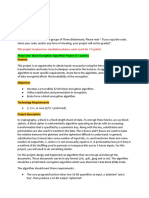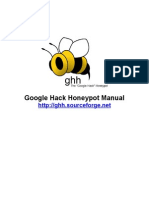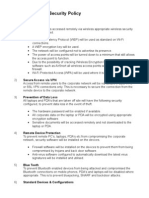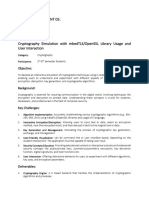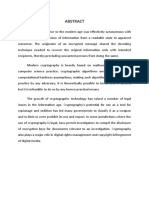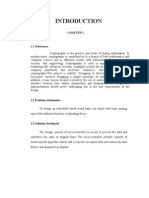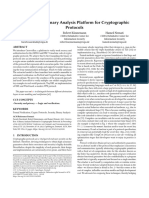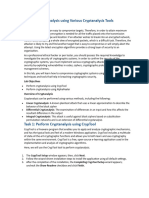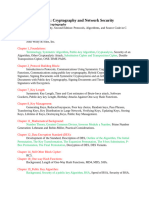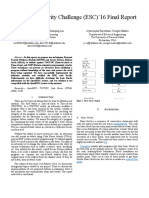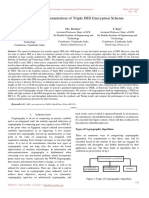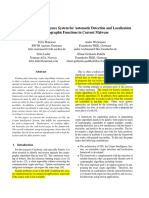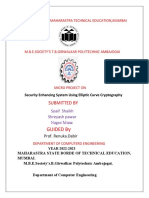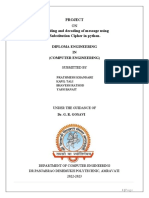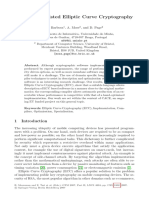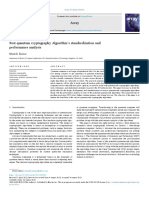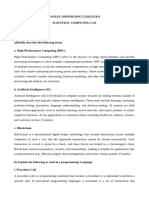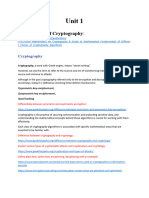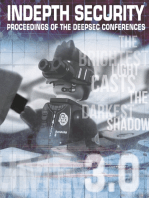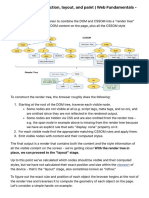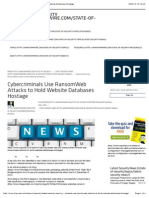Crypto Tool
Crypto Tool
Uploaded by
Vinayak WadhwaCopyright:
Available Formats
Crypto Tool
Crypto Tool
Uploaded by
Vinayak WadhwaOriginal Description:
Copyright
Available Formats
Share this document
Did you find this document useful?
Is this content inappropriate?
Copyright:
Available Formats
Crypto Tool
Crypto Tool
Uploaded by
Vinayak WadhwaCopyright:
Available Formats
INTRODUCTION TO CRYPTOOL:
What is CrypTool?
Freeware program with graphical user interface
Cryptographic methods can be applied and analysed
Comprehensive online help (understandable without deeper cryptography
knowledge)
Contains nearly all stateoftheart cryptography functions
Easy entry into modern and classical cryptography
Not a hacker tool
2. Why CrypTool?
Origin in awareness initiative of a financial institute
Developed in close cooperation with universities
Improvement of university education and infirm training
3. Target group
Core group: Students of computer science, business computing and
mathematics
But also for: computer users, application developers, employees
Prerequisite: PC knowledge
Preferable: Interest in mathematics and/or programming
CRYPTOOL PROGRAM
All functions integrated in a single program with consistent graphical
interface
Runs on Win32
Cryptography libraries from Secude and OpenSSL
Long integer arithmetic from Miracl and GMP, Lattice base reduction via
NTL (Shoup)
ADDITIONAL FUNCTIONS
Homophone and permutation encryption (Double Column Transposition)
PKCS #12 import and export for PSEs (Personal Security Environment)
Generate hashes of large files, without loading them
Flexible bruteforce attacks on any modern symmetric algorithm
ECC demonstration (as Java application)
Password Quality Meter (PQM) and password entropy
CONCEPTS FOR A USERFRIENDLY INTERFACE
1. Context sensitive help (F1)
F1 on a selected menu entry shows information about the algorithm/method.
F1 in a dialog box explains the usage of the dialog.
These assistances and the contents of the super ordinate menus are cross
linked in the online help.
2. Paste of keys in keyinput dialog
CTRLV can be used to paste contents from the clipboard.
Used keys can be taken out of cipher text windows via an icon in the icon
bar. A corresponding icon in the keyinput dialog can be used to paste the
key into the key field.
A CrypToolinternal memory which is available for every method is used
(helpful for large specific keys e.g. homophone encryption).
CHALLENGES FOR DEVELOPERS (EXAMPLES)
1. Many functions running in parallel
Factorisation runs with multithreaded algorithms
2. High performance
Locate hash collisions (birthday paradox) or perform bruteforce analysis
3. Consider memory limits
Floyd algorithm (mappings to locate hash collisions) or factorisation with
quadratic sieve
4. Time measurement and estimates
Display of elapsed time while using bruteforce
5. Reusability / Integration
Forms for prime number generation
RSA cryptosystem (switches the view after successful attack from public key user
to
private key owner)
6. Partly automate the consistency of functions, GUI and online help
(including different languages)
CRYPTOOL EXAMPLES
Overview of examples:
1. Encryption with RSA / Prime number tests / Hybrid encryption and digital
certificates / SSL
2. Digital signature visualised
3. Attack on RSA encryption (modul N too short)
4. Analysis of encryption in PSION 5
5. Weak DES keys
6. Locating key material (NSA key)
7. Attack on digital signature through hash collision search
8. Authentication in a clientserver environment
9. Demonstration of a sidechannel attack (on hybrid encryption protocol)
10. Attack on RSA using lattice reduction
11. Random analysis with 3D visualisation
12. Secret Sharing using the Chinese Remainder Theorem (CRT) and Shamir
13. Implementation of CRT in astronomy (solving linear modular equation
systems)
14. Visualisation of symmetric encryption methods using ANIMAL
15. Visualisation of AES
16. Visualisation of Enigma encryption
17. Generation of a message authentication code (MAC)
18. Hash demonstration
19. Learning tool for number theory and asymmetric encryption
20. Point addition on elliptic curves
21. Password quality meter (PQM) and password entropy
22. Bruteforce analysis
23. CrypTool online help
EXAMPLE OF USAGE OF CRYPTOOL: DIGITAL SIGNATURE
Future CrypTool Development
Reuse the comprehensive set of algorithms, included libraries and interface
elements as foundation
Free of charge training in Frankfurt, how to start with CrypTool
development
Advantage: Your own code does not disappear, but will be maintained
CRYPTOOL SUMMARY
THE elearning program for cryptology
Over more than 10 years a successful open
source project
More than 200,000 downloads
International utilisation in schools, universities as
well as companies and government agencies
Extensive online help and documentation
Available for free and multilanguage support
You might also like
- Algorithm VisualiserDocument16 pagesAlgorithm VisualiserVaishnavi/ven .PNo ratings yet
- Progress in Multivariate Cryptography Systematic ReviewDocument34 pagesProgress in Multivariate Cryptography Systematic ReviewFai ShararNo ratings yet
- CCCY 312: Cryptography Project 1, Due Date: Nov. 25 GroupsDocument4 pagesCCCY 312: Cryptography Project 1, Due Date: Nov. 25 GroupsMohamed AlomariNo ratings yet
- CIS Controls v7.1 Mapping To ISO 27001 v19.07Document46 pagesCIS Controls v7.1 Mapping To ISO 27001 v19.07Geraldin Delgado100% (1)
- Google - Google Hack Honeypot ManualDocument9 pagesGoogle - Google Hack Honeypot ManualVinayak Wadhwa100% (2)
- Quiz4 PDFDocument8 pagesQuiz4 PDFЮлия Котяй100% (1)
- Remote Access Policy Word TemplateDocument2 pagesRemote Access Policy Word Templateapi-3736636100% (1)
- Cryptography Simulation with mbedTLSOpenSSL Library Usage and user interactionDocument2 pagesCryptography Simulation with mbedTLSOpenSSL Library Usage and user interactionroanek jenaNo ratings yet
- Data Encryption StandardDocument37 pagesData Encryption Standardchristian MacNo ratings yet
- SoK - Computer-Aided Cryptography - IEEE SP2021Document19 pagesSoK - Computer-Aided Cryptography - IEEE SP2021Nirosh KumarNo ratings yet
- TYBSc IT SyllabusDocument27 pagesTYBSc IT SyllabusRohit R RahateNo ratings yet
- 12.nivas MuthuDocument21 pages12.nivas MuthuFaizane RasoolNo ratings yet
- 4.83 TYBSc ITDocument27 pages4.83 TYBSc ITrehan shaikhNo ratings yet
- Group Dwndnew - SyllabusDocument26 pagesGroup Dwndnew - SyllabussnehabenbumbadiyaNo ratings yet
- B.Tech. Computer: Uka Tarsadia UniversityDocument6 pagesB.Tech. Computer: Uka Tarsadia UniversityPatelNo ratings yet
- High Speed Cipher Cracking: The Case of Keeloq On CUDA: Rypto Eeloq EeloqDocument12 pagesHigh Speed Cipher Cracking: The Case of Keeloq On CUDA: Rypto Eeloq EeloqNemo NemonivichNo ratings yet
- Synopsis of ThesisDocument5 pagesSynopsis of Thesishimanshus13No ratings yet
- Encryption and Decryption System Using Rc4Document11 pagesEncryption and Decryption System Using Rc4Atul KhadeNo ratings yet
- Advance Encryption StandardDocument85 pagesAdvance Encryption Standarduttamsudhir100% (1)
- Network Security ManualDocument35 pagesNetwork Security ManualHarsha GangwaniNo ratings yet
- UntitledDocument22 pagesUntitledNarinder Singh KaboNo ratings yet
- CT Book enDocument551 pagesCT Book enderejeNo ratings yet
- CrypTool BookDocument552 pagesCrypTool BookInteramericano ArequipaNo ratings yet
- 10-IDEA Encryption-18-01-2024Document4 pages10-IDEA Encryption-18-01-2024EXTERMINATORNo ratings yet
- CryptoBap: A Binary Analysis Platform For Cryptographic ProtocolsDocument23 pagesCryptoBap: A Binary Analysis Platform For Cryptographic ProtocolsxwmxkunNo ratings yet
- TYIT New SyllabusDocument26 pagesTYIT New SyllabusImtishal Ali0% (1)
- RC4 CryptographyDocument61 pagesRC4 Cryptographyga18392100% (3)
- Chapter - 1Document35 pagesChapter - 1Manish AeronNo ratings yet
- Googles Threat Model For Post-Quantum CryptographyDocument8 pagesGoogles Threat Model For Post-Quantum CryptographysgsmarazNo ratings yet
- Thesis On Image Encryption and DecryptionDocument5 pagesThesis On Image Encryption and Decryptionbseqvt7f100% (1)
- Perform Cryptanalysis Using Various Cryptanalysis Tools-1Document23 pagesPerform Cryptanalysis Using Various Cryptanalysis Tools-1jsolaresrNo ratings yet
- KeyloggerDocument16 pagesKeylogger510821205029 ITNo ratings yet
- Gallo SBSeg11Document15 pagesGallo SBSeg11MobiwankNo ratings yet
- CNS Course-Outline - Marked Ja Porano HoyacheDocument3 pagesCNS Course-Outline - Marked Ja Porano HoyacheNïloy Ft AminulNo ratings yet
- MCQ & Subjective 707Document15 pagesMCQ & Subjective 707Shahid Azeem0% (2)
- ESC CSAW 16 Report - UTDDocument6 pagesESC CSAW 16 Report - UTDtrimcaoNo ratings yet
- MCQS - Cs 707 Paper-SolvedDocument21 pagesMCQS - Cs 707 Paper-SolvedShahid AzeemNo ratings yet
- Design and Implementation of Triple DES Encryption SchemeDocument7 pagesDesign and Implementation of Triple DES Encryption SchemeAnonymous lPvvgiQjRNo ratings yet
- CIS: The Crypto Intelligence System For Automatic Detection and Localization of Cryptographic Functions in Current MalwareDocument8 pagesCIS: The Crypto Intelligence System For Automatic Detection and Localization of Cryptographic Functions in Current MalwarewaqasNo ratings yet
- Project EditorDocument35 pagesProject Editorsteevejan541No ratings yet
- Skill Development ProgramDocument19 pagesSkill Development ProgramHarsha G HNo ratings yet
- Gujarat Technological University: Page 1 of 6Document6 pagesGujarat Technological University: Page 1 of 6Parshw PatelNo ratings yet
- Project Synopsis On Encryption AlgorithmsDocument15 pagesProject Synopsis On Encryption AlgorithmsNo MercyNo ratings yet
- It8761 Set 1Document3 pagesIt8761 Set 1yaminishrvaniNo ratings yet
- Microcontr Sorbonne UniversiteDocument11 pagesMicrocontr Sorbonne UniversiteDiana AugustinaeNo ratings yet
- Computer Crytography-Mit 5114-Take Away 2Document10 pagesComputer Crytography-Mit 5114-Take Away 2JoelNo ratings yet
- Shreyash Nis Project NisDocument10 pagesShreyash Nis Project NisShreyashNo ratings yet
- Compusoft, 3 (10), 1157-1160 PDFDocument4 pagesCompusoft, 3 (10), 1157-1160 PDFIjact EditorNo ratings yet
- PWP ReportDocument15 pagesPWP Reportcomedy loverNo ratings yet
- Final DraftDocument11 pagesFinal DraftshreyashextraNo ratings yet
- Deep Belief Nets in C++ and CUDA C: Volume 2: Autoencoding in the Complex DomainFrom EverandDeep Belief Nets in C++ and CUDA C: Volume 2: Autoencoding in the Complex DomainNo ratings yet
- Paper Farwa2 PDFDocument2 pagesPaper Farwa2 PDFkainat munawarNo ratings yet
- 1 s2.0 S2590005622000777 MainDocument27 pages1 s2.0 S2590005622000777 MainMila Datul MuharromahNo ratings yet
- ChapterOne CodelessDeepLearning KNIME BookDocument8 pagesChapterOne CodelessDeepLearning KNIME BooklfgellonNo ratings yet
- Project TemplateDocument11 pagesProject TemplateMani KandanNo ratings yet
- Review 789Document4 pagesReview 789Huỳnh Đông HênNo ratings yet
- "Implementation of Keylogger Using HOOKUP Algorithm": Project SynopsisDocument7 pages"Implementation of Keylogger Using HOOKUP Algorithm": Project Synopsisraman dwivediNo ratings yet
- DownloadDocument10 pagesDownloadAtul GautamNo ratings yet
- Scomp CatDocument13 pagesScomp CatOmosh Fanuz Juma jnr.No ratings yet
- Theory Practice Cryptography Network Security All 13Document155 pagesTheory Practice Cryptography Network Security All 13AstrohanumanNo ratings yet
- TOPICS Not PresentDocument3 pagesTOPICS Not Presentchaitanya252533No ratings yet
- CRNS Syllabus Copy Lab and SubjectDocument4 pagesCRNS Syllabus Copy Lab and SubjectChaturya GottimukkulaNo ratings yet
- In Depth Security Vol. III: Proceedings of the DeepSec ConferencesFrom EverandIn Depth Security Vol. III: Proceedings of the DeepSec ConferencesNo ratings yet
- Pro Cryptography and Cryptanalysis: Creating Advanced Algorithms with C# and .NETFrom EverandPro Cryptography and Cryptanalysis: Creating Advanced Algorithms with C# and .NETNo ratings yet
- Dom CssomDocument4 pagesDom CssomVinayak WadhwaNo ratings yet
- Banda2014 PDFDocument8 pagesBanda2014 PDFVinayak WadhwaNo ratings yet
- Cybercriminals Use RansomWeb Attacks To Hold Website Databases HostageDocument4 pagesCybercriminals Use RansomWeb Attacks To Hold Website Databases HostageVinayak WadhwaNo ratings yet
- SNORT ToolDocument11 pagesSNORT ToolVinayak WadhwaNo ratings yet
- TelenursingDocument15 pagesTelenursingVinayak WadhwaNo ratings yet
- 04 Technical WritingDocument33 pages04 Technical WritingVinayak WadhwaNo ratings yet
- What Is New in Cloud SecurityDocument8 pagesWhat Is New in Cloud SecurityVinayak WadhwaNo ratings yet
- Css322y12s2h01 Des ExamplesDocument2 pagesCss322y12s2h01 Des ExamplesAbhishek MatNo ratings yet
- Tel Net Pres Brazil 2009Document18 pagesTel Net Pres Brazil 2009Vinayak WadhwaNo ratings yet
- Wep CrackingDocument5 pagesWep CrackingVinayak WadhwaNo ratings yet
- Transposition CiphersDocument8 pagesTransposition CiphersVinayak WadhwaNo ratings yet
- Software SecurityDocument39 pagesSoftware SecurityVinayak WadhwaNo ratings yet
- Nurse Telephone TriageDocument20 pagesNurse Telephone TriageVinayak WadhwaNo ratings yet
- Chapter 4: Advanced SQLDocument57 pagesChapter 4: Advanced SQLVinayak Wadhwa100% (2)
- Lossless JoinDocument25 pagesLossless JoinVinayak WadhwaNo ratings yet
- Views in SQLDocument10 pagesViews in SQLVinayak WadhwaNo ratings yet
- Stream Cipher Course-IDocument79 pagesStream Cipher Course-Icarygrant_2003No ratings yet
- Fix The SSL-TLS Handshake Failed ErrorDocument6 pagesFix The SSL-TLS Handshake Failed ErrorvishalrajkumarNo ratings yet
- Cryptography and Network Security: Vi Sem BcaDocument42 pagesCryptography and Network Security: Vi Sem Bcasanthosh RNo ratings yet
- MYID Kiosk User Guide V1.0Document34 pagesMYID Kiosk User Guide V1.0maguvuNo ratings yet
- Kendriya Vidyalaya Rajkot: Name-Class - Roll-No - Subject - TopicDocument10 pagesKendriya Vidyalaya Rajkot: Name-Class - Roll-No - Subject - Topiciiidddkkk 230No ratings yet
- SSL CheckerDocument2 pagesSSL CheckerLifalakhe MaganganeNo ratings yet
- Cyber Threat Intelligence Program PlanDocument22 pagesCyber Threat Intelligence Program Planapi-737202431No ratings yet
- ESE Question Bank Short NotesDocument5 pagesESE Question Bank Short NotesfalgunagohelNo ratings yet
- Introduction To Networking Touchstone 4Document23 pagesIntroduction To Networking Touchstone 4keosamnangofficial1No ratings yet
- University of Northern Philippines: College of Communication and Information TechnologyDocument5 pagesUniversity of Northern Philippines: College of Communication and Information TechnologyJanelle BilgeraNo ratings yet
- BRA Symmetric Encryption Algorithm: Remzi AKTAYDocument4 pagesBRA Symmetric Encryption Algorithm: Remzi AKTAYaijbmNo ratings yet
- Principles of Information Security, 5th Edition: January 2015Document9 pagesPrinciples of Information Security, 5th Edition: January 2015Muhammad RizaldiNo ratings yet
- Ccna Security Chapter 8Document16 pagesCcna Security Chapter 8albertof00No ratings yet
- Key Management 02062023 025048pmDocument4 pagesKey Management 02062023 025048pmwajahatrasool2003No ratings yet
- CISSP Student Guide V2.0Document913 pagesCISSP Student Guide V2.0thetzo83% (6)
- Asymmetric key-RSADocument26 pagesAsymmetric key-RSASmitha GVNo ratings yet
- Digital Signature: Cryptography and Network Security 1Document12 pagesDigital Signature: Cryptography and Network Security 1Manjul GuptaNo ratings yet
- CCTV Dan AksesDocument4 pagesCCTV Dan Aksesdan diNo ratings yet
- CH 13 Digital SignatureDocument17 pagesCH 13 Digital SignaturetartarNo ratings yet
- Exercise 1Document9 pagesExercise 1Bình QuốcNo ratings yet
- MikroTik RB750 Configuration Guide For IPsec With NS1000 - Ver1.0 - FinalDocument58 pagesMikroTik RB750 Configuration Guide For IPsec With NS1000 - Ver1.0 - Finalalberto VasquezNo ratings yet
- Compliant User StatusDocument4 pagesCompliant User StatusMy PES AccountNo ratings yet
- Sol AssignmentDocument4 pagesSol AssignmentERMIAS AmanuelNo ratings yet
- Computer System Security: 1-1 W (CC-Sem-3 & 4)Document155 pagesComputer System Security: 1-1 W (CC-Sem-3 & 4)श्री KrishnaNo ratings yet
- How Does Groww Keep My Data Safe PDFDocument2 pagesHow Does Groww Keep My Data Safe PDFrk sahuNo ratings yet
- Multifactor Authentication (MFA) Options For Netweaver AS and S4HANA On-PremiseDocument2 pagesMultifactor Authentication (MFA) Options For Netweaver AS and S4HANA On-PremiseAdrianNo ratings yet
- Comptia: Comptia Cysa+ Certification Exam (Cs0-002)Document8 pagesComptia: Comptia Cysa+ Certification Exam (Cs0-002)DumpsLeaderNo ratings yet


